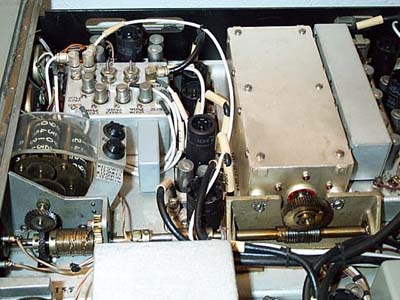 |
| R1230/FLR. This is a 1960's vintage receiver (Photo courtesy National Radio Products) |
Shortwave Receivers Past and Present by Fred Osterman, offers the following information on the R1230 (with additions and corrections) :
Type: General Coverage Countermeasures Receiver
Design: Triple Conversion Superheterodyne with IF's of 1625-1725 KHz, 220 KHz and 65 KHz.
Coverage 2 - 32 MHz
Bandwidth: 60 KHz
Antenna Input: SO239
Modes: Whatever happens to be present in the 60 kHz passband.
Circuit Complement: 16 miniature tubes and 16 nuvistors.Comments: Ranges: 2-4, 4-8, 8-16, and 16-32 MHz. The large center knob tunes the 10 MHz, 1 MHz and 100 kHz positions which are displayed on an odometer type display to the right of the two meters. The right meter is labeled 100 KC TUNING. This shows when tuning lock is achieved. Then the 10 kHz, 1 kHz and 100 Hz positions are tuned by the second large knob and is displayed on the second odometer display. This is not a typical or complete receiver. It provides wideband output for further processing such as for direction finding. A separate power supply can support up to six receivers when used in a direction finding configuration. It is believed the the R-1230 was the last tube-type military receiver produced by National. This extremely interesting receiver has a plate on the front that states: R-1230/FLR RECEIVER, COUNTERMEASURES. MANUFACTURED FOR DEPARTMENT OF NATIONAL DEFENCE BY CONTRACTOR NATIONAL RADIO COMPANY. It may have been produced for the British or Canadian government. The tuning capacitor is reportedly gold plated.
Dimensions 19"W x 5.7" H
Made in: United States.
Rarity: Extremely Scarce
 |
| 1230/FLR. Portion of interior view. This radio was not designed for use as a stand alone receiver. (Photo courtesy Milradio 73 web site) |
 |
| This nameplate bears the Department of National Defence name. |
Tom Brent, a radio collector from Dewdny BC, provides some additional information on the receiver. "When I came across my first R-1230 in January 1983, it was a unit bearing US military identification. All of the subsequent ones I have come across were affixed with "Canadian Armed Forces" identification plates. It's hard to believe, but I once found 15-20 of them in a garbage bin behind a test equipment supplier/refurbisher in Burnaby, B.C. There are two parts required to make a complete R1230 receiver. It requires the R-1230 itself and the O-1187 oscillator/power supply. The O-1187 is very difficult to locate.
The receiver section contains RF amplifiers, converter stages (it uses
triple conversion), IF amps, and AGC system, that would be found in any
HF radio. However, it is important to note that it does NOT have any on-board
signal detection or AF stages. The tuning range is 2 - 32 MHz in four
bands and the frequency stability is exceptional. It employs 32 tubes (includes
16 type 7586 nuvistors) and 13 semiconductors. The oscillator in the power
supply section operates at 100 kHz and is for reference only. If memory
serves me correctly it is for setting the megacycle control on the receiver
to zero beat. The output signal from the receiver is at the 3rd IF frequency
of 65 kHz and, referring to my 20 year old notes again, it has a bandwidth
of 60 kHz.
Although I have had a number of these receivers, I never powered any of them up, mostly because I never had any of the power supplies. When I had a chance to buy a power supply, I didn't have the receiver. Besides, a receiver with an IF bandwidth of 60 kHz is something I wouldn't have much use for on the crowded amateur or shortwave HF bands where the name of the game was (and still is) selectivity.
According to my notes, some US military R-1125's were converted into
R-1230's so there can't be much difference between them".